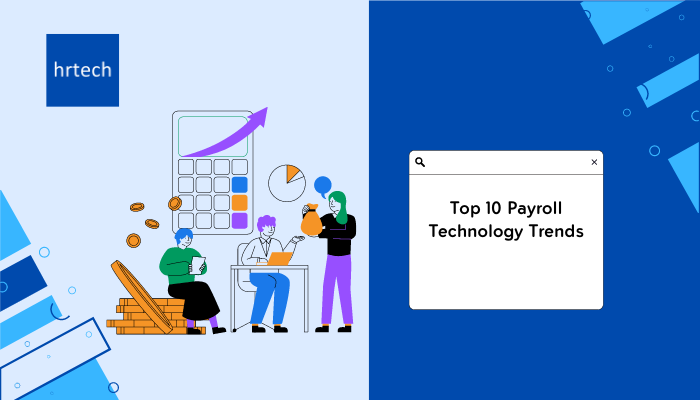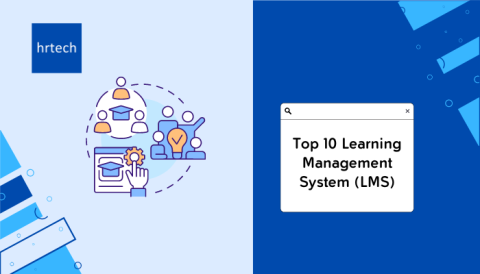Imagine the payroll system to be fully automated, and secure. Employees are able to access their pay information anytime, anywhere.
And errors? They are a thing of the past.
This is the future of payroll, and it’s much closer than we think.
Let’s explore the top 10 payroll technology trends that are essential in 2024 and in the upcoming years.
10 Must-Know Payroll Technology Trends In 2024
1. AI-Powered Automation
AI is significantly changing how payroll processes are done.
According to the Global Payroll Association, 40% of payroll tasks done today can be automated through AI. In the past, payroll was a tedious, manual task prone to errors. Payroll professionals spent hours calculating wages, taxes, and deductions for each employee.
Today, AI-powered tools can easily automate the majority of payroll tasks.
For example, AI can accurately calculate pay based on time worked, automatically apply tax rates and deductions, and generate payslips in seconds.
Furthermore, AI-powered Chatbots are becoming quite popular these days and come integrated with popular payroll softwares. These chatbots are designed to handle common employee payroll questions, freeing up payroll staff for higher-level work. As AI advances, it will take on even more complex payroll tasks. Machine learning algorithms will spot errors with more accuracy.
AI-powered predictive analytics will forecast payroll costs based on factors like hiring plans and turnover rates. This will further help organizations budget more effectively and make informed decisions.
2. Cloud-Based Payroll
Cloud technology has made payroll more accessible and collaborative than ever.
Traditionally, payroll data was stored on office servers and only accessible by the payroll team. This made it hard to share information and work remotely.
But now, 54% of organizations use cloud-based payroll systems. Employees can access pay slips, tax forms, and PTO balances anytime from any device.
It’s also much easier for the HR and finance teams to securely share real-time payroll data. In addition, Cloud payroll solutions make it easier to ensure compliance and data security.
With advancements in technology and the rise of remote work, the majority of companies will process payroll in the cloud in the upcoming years. In fact, over time, fully cloud-based platforms will emerge that offer advanced features and flexibility. For instance, microservices architecture will allow payroll to integrate with other HR systems in a hassle-free way. APIs will enable custom integrations to meet unique business needs.
The shift to the cloud will make payroll more efficient and employee-friendly. Self-service options will allow employees to update their own information. Centralized data will also give leaders full visibility into payroll metrics.
3. Advanced Automated Reporting
Now, as we saw with the rise of AI and increasing demand for cloud-based payroll systems, the payroll reporting department is also getting smarter and faster. In the past, payroll teams spent days manually compiling reports in spreadsheets. Gathering data from different sources and formatting reports was time-consuming.
New automated reporting tools are changing the entire process.
With just a few clicks, payroll professionals can generate reports on key metrics like labor costs, overtime, and turnover. Visual dashboards highlight trends and anomalies at a glance. Payroll software automatically keeps reports up-to-date as new data comes in.
The future of payroll reporting is even more bright. AI could analyze payroll data in real-time to spot issues before they escalate. For example, it might report a sudden spike in overtime that needs investigation. Predictive analytics could forecast headcount costs based on growth plans, enabling more accurate budgeting.
Intelligent payroll reporting helps leaders make informed decisions quickly. With real-time insights, they can identify cost-saving opportunities, ensure compliance, and support the business strategy.
Automated reporting also frees payroll professionals from repetitive report-pulling. Instead, they can focus on understanding the data and providing valuable recommendations.
4. Integration With Other HR Platforms
Payroll is becoming more connected with the main HR ecosystem. Historically, payroll was a separate function from other HR activities. Employee data was duplicated across different systems, leading to errors and inconsistencies.
Today, many organizations have started focusing on integrating their payroll systems with other HR platforms.
With strong integration, an employee’s hire date, job title, and compensation information flow seamlessly into payroll. Time and attendance data connects directly for faster, more accurate pay calculations. But still, only 29% of users are satisfied with the integration capabilities of their HR tech applications. So there is still a lot of scope of improvement in these areas as we move forward.
In fact, 15% of the organizations are implementing HRIS (Human Resource Information System) —the all-in-one type software solutions—for having everything integrated in one place.
These bring together payroll, HR, talent management, and workforce planning in a single platform.
Connecting payroll with HR systems has major benefits. It ensures a single, reliable source of employee data.
Integrated data powers advanced workforce analytics. HR and payroll teams can collaborate more effectively on key initiatives like pay equity. As organizations prioritize employee experience, integration will become even more crucial.
5. Self-Service Portals
Employee self-service is becoming a must-have for modern payroll.
In the past, employees had to contact payroll for even simple questions about their pay or tax forms. This was time-consuming for both parties and could lead to delays. Today, things have changed. According to research, more than 8 out of 10 employees highlight that they are offered self-service portals in their work. This just shows how important it is in payroll technology.
In fact, according to a study by Paychex, around 73% of full-time employees want better employee self-service.
Employee self services portals allow employees access their pay slips, update their personal information, and view PTO balances on demand.
Some self-service portals even allow employees to run scenarios to see how changes like 401k contributions impact their take-home pay.
In the coming years, this trend is going to be even more popular—moving towards —offering a complete self-service platform to employees.
This will be beneficial for both employees and companies, saving time and enhancing productivity for all.
Advanced portals will offer personalized financial wellness resources and allow employees to update their own direct deposit information. Chatbots will provide instant answers to common payroll questions. The self-service feature helps employees get the payroll info they need quickly and easily. This improves the employee experience and frees up payroll staff to focus on other important tasks.
6. Mobile-Friendly Payrolls
Mobile access is a growing priority for payroll.
In the past, payroll systems were designed for desktop use only. This made it hard for employees to access their payroll information on the go. It also limited payroll staff’s ability to work flexibly. Now, mobile-responsive design is becoming more popular. Employees prefer mobile access for payroll self-service. Payroll staff also like to handle tasks like approvals from their smartphone.
Top payroll software solutions like Gusto and Paychex also offer user-friendly mobile apps. Forward-thinking organizations are taking mobile optimization even further. They’re designing payroll workflows with a mobile-first mindset.
For instance, they’re using mobile-friendly biometric authentication for secure access. Geofencing capabilities remind employees to punch in/out when they’re at a worksite.
Using mobile helps organizations meet the expectations of an increasingly digital workforce. It supports flexible work arrangements and keeps employees connected to their payroll information all the time. Mobile-friendly systems also enable location-based timekeeping and mileage tracking.
7. Instant Wage Access
On-demand pay is an emerging trend in payroll. The traditional two-week pay cycle doesn’t align with many employees’ financial needs. According to a PWC survey, 47% of employees (who earn $100,000 or more—annually) say they remain stressed about their finances—which is really concerning and worth noting.
This financial stress can eventually lead to disengagement and even turnover. A solution to this problem is—instant wage access, also known as earned wage access (EWA).
It allows employees to access a portion of their earned wages before payday.
If an employee has worked 30 hours so far in a pay period, they could request 50% of those earnings in advance. The remainder is paid on the regular payday.
Major companies like Walmart already offer EWA. Studies show that 60% of US employees already like the idea of withdrawing their earnings before their actual payday.
So considering all these, in the coming years, this trend of on-demand pay is expected to increase even more. Various software solutions are also evolving to make EWA administration easier. Some providers handle the early wage payments themselves, so it’s no extra work for the payroll department.
EWA can be a powerful financial wellness benefit.
It helps employees avoid late fees, overdraft charges, and payday loans. This reduces financial stress so employees can focus on their work. EWA also helps companies stand out in a competitive talent market.
8. Real-Time Tax Compliance
Payroll compliance is getting more complex. Tax code changes happen frequently and as a result organizations need a solid system to keep up with the new payroll regulations.
Real-time compliance checks are becoming essential. Payroll systems now cross-reference employee locations with up-to-date tax and employment laws.
The software flags any required tax withholdings or filings based on the required regulations. This automation reduces audit risk and ensures employees are taxed correctly.
Predictive compliance is the next phase. In the coming years, the role of AI will become more important in monitoring regulatory changes and upcoming effective dates. It will notify payroll staff proactively when an action is required to stay compliant.
As the workforce becomes more distributed and regulations evolve, real-time compliance is a must. It saves payroll teams from the tedious work of tracking requirements manually.
This minimizes human error and allows payroll to work strategically. Organizations that fail to comply can face costly penalties.
9. Automated Tax Calculations And Deductions
Calculating taxes is one of the most complex and error-prone parts of payroll. Tax rates and rules vary widely by location and employee situation. And it is one of the reasons why many payroll professionals struggle with tax compliance.
Automated tax calculations are becoming increasingly popular nowadays. Payroll systems now have built-in tax engines that automatically determine the appropriate taxes for each employee based on their work location and local regulations. The software calculates and withholds the correct amounts each pay period.
The future of tax automation goes beyond basic calculations. Over the years, AI-powered systems will proactively alert payroll of tax law changes that impact their organization.
The software will recommend actions to stay compliant, like updating withholding forms. AI process automation will handle tasks like filing quarterly returns. Automating tax processes reduces the risk of costly mistakes. It ensures employees are taxed accurately and consistently.
This helps organizations avoid penalties and maintain compliance. Automated calculations also save payroll staff hours of manual work.
10. Strong Controls To Prevent Errors
Payroll errors can be costly in terms of money, time, and employee trust.
Did you know that payroll errors can cost a company up to 8% of their total annual payroll?
That’s why strong controls are a growing priority. Payroll systems now have built-in checks and security systems to catch potential errors before they happen. For example, the software might flag an unusually high bonus amount for review. Multi-step workflows ensure that sensitive changes like pay rates are properly authorized.
Going forward, AI will play a bigger role in payroll control and auditing. Machine learning algorithms will analyze payroll data in real-time to spot anomalies like duplicate payments. AI process automation will handle differences between payroll and accounting data.
Advanced controls protect the accuracy and integrity of payroll. They prevent mistakes that can damage employee morale and the company’s reputation. With automated checks and balances, organizations can reduce payroll risk without overburdening staff.
Conclusion
So that’s all about the top payroll technology trends in 2024. Some of the most common themes among these trends include efficiency and automation, employee experiences, compliance, and security.
As the workforce becomes more distributed and remote work becomes more prevalent, these trends will become crucial for success.
Implementing new payroll technologies can be challenging at first, but the benefits are really worth it. At hrtech, we’re here to guide you through the process and help you select the right software solutions for your needs. Learn more now!





